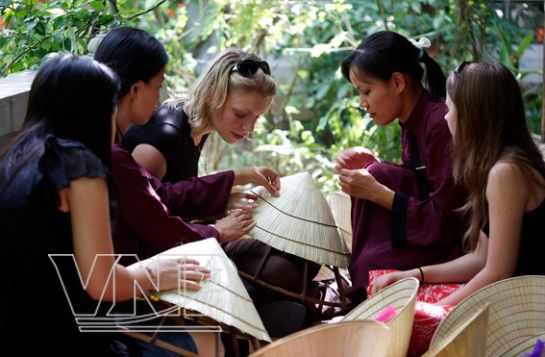Tripatini
the world's smartest travel social network
Conical Hat in Vietnam
For many years, Non (traditional conical hats woven from palm leaves) have been close to the daily life of Vietnamese women. The image of the Non was engraved on ancient objects, such as Ngoc Lu Bronze Drum and Dao Thinh Bronze Jar dated to 2,500-3,000 years ago.
Through time the Non has undergone many changes in terms of style and materials. Originally the Non was woven and plaited. Not until the 3rd century BC when iron was utilized, did people start using needles to sew the Non.

A documentary photo of Vietnamese women of the past wearing Non.
The materials for making Non are simple, including leaves of a species of palm for making the top, fibre from the bark of Moc tree (that is now replaced by nylon threads) for stitching the leaves together and bamboo for making the brim.

A painting on Vietnamese women wearing Ao dai and Non.

Souvenir items featuring the image of girls in long dress and Non.
First, artisans have to make the palm leaves flat by placing them on a hot iron plate and pressing them with a handful of cloth at a precise temperature so not to burn or discolour the leaves, whereas to cold the iron plate will not achieve the flatness required.
The leaves are smoked with sulphur to be white and resistant to mould. The long bamboo pieces used to make the hat brim must be put on the smoking-shelf to resist worm.
Making the frame of a Non
There are many Non-making villages in Vietnam. Of which, Chuong Village in Thanh Oai District, Hanoi is famous nationwide for its beautiful products. The village’s products have 16 layers of rings. The number of rings has remained unchanged for many years. The beauty of Non depends much on the skilful hands of artisans who create regular stitches and hide any irregularity and knot in the layer of palm leaves.
Foreign tourists learn about the Non-making craft of Vietnamese people
There are many kinds of Non, such as Non chop nhon dau (spiky conical hat), Non thung rong vanh (basket-shaped conical hat), Non ba tam (flat palm hat with fringes) which help protect those who live in the sunny and rainy areas from the blazing sunlight and rain. Non sometimes has a mirror attached to the inside. Artisans also sandwich patterns or images of bamboo grove, rice field and poems in the middle of layers of leaves that can be viewed when held up to the light. This kind of Non is called Non bai tho.
Drawing patterns on Non.
For Vietnamese women, Non is considered an indispensable part of their traditional attire, including Ao dai (long dress), loose-fitting blouse, black silk skirt, red brassier, etc. It helps highlight the beauty, femininity and gracefulness of Vietnamese women. Under the conical hat, the eyes, smiles and neck of the wearer seem to be more attractive.
The Non has become a symbol of Vietnamese women.

Ethnic women also use Non in their daily life.

Non is close to the life of Vietnamese women.
Non helps highlight the beauty of Vietnamese women.

Non is an dispensable object of Vietnamese female farmers.

Non-shaped lamps are displayed at Festival Hue.

A corner of Non-selling market in Hue.
Almost all Vietnamese people feel close to and have deep attachment to Non. The image of girls in traditional long dress and Non has been absorbed into folk music and songs and becomes a beautiful symbol of Vietnam.
» Also you like our http://minmaxvn.wordpress.com/about/ - http://minmax-vn.blogspot.com/ - http://minmaxtravel.blog.com/aboutus/
Videos
Groups
-
India
173 members
-
Tour Operators
873 members
-
Ireland
93 members
-
South Dakota
17 members
-
Azerbaijan
17 members
-
Shopping the World
55 members
-
Tech for Travel/Hospital…
87 members
-
Andorra
26 members
-
Online Corner
75 members
-
Minnesota
22 members
-
Backpackers & Hostels
84 members
-
Portugal
60 members
-
Turks and Caicos
26 members
-
Agritourism/Farmstays
72 members
-
Zambia
21 members
© 2024 Created by EnLinea Media.
Powered by
![]()
Badges | Report an Issue | Privacy Policy | Terms of Service





You need to be a member of Tripatini to add comments!
Join Tripatini